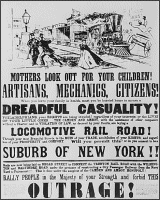
Anti-railroad Propaganda Poster: The Growth of Regionalism, 1800 - 1860
Background
Did you ever wonder why people from Chicago call carbonated water "pop" while New Yorkers call it "soda"? Or why Southerners tease Northerners for talking too fast, driving too fast, and even eating too fast? Well, the United States has always had regional differences. Today, the regions may be difficult to draw a line around, but from 1800 to 1860, those lines clearly existed. The United States was divided into three distinct regions: the North, the South, and the West. While each region remained dedicated to the "American Dream," each attempted to reach the dream in significantly different ways. The North realized her dreams with industry and commerce while the South continued to prosper with her plantations and subsistence farms. The Western frontier opened up to both commercial farms and manufacturing, showing a little bit of both her northern and southern heritage.
Regional differences deepened when the national government began expanding, meeting foreign entanglements and domestic trouble. The War of 1812 brought controversy to a head. The young country's armed forces were not equipped for a war, lacking both an able staff and an adequate number of enlisted men. The burden fell on the states, recruiting militia men and relying heavily on western frontiersmen. Not all states cooperated; the North was against the war, primarily for economic reasons. The war ended up stimulating economic change, spurring the production of manufactured goods, which the North eagerly provided. Factories sprang up across the North and an influx of immigrants satisfied the demand for labor.
The war exposed not only weaknesses in defense, but also in transportation. Modes and methods of transportation were totally inadequate. Generals moved troops slowly by carriages, or on foot, on poorly developed roads. President James Madison supported the idea of internal improvements, yet he vetoed an internal improvements bill, which would have provided for the construction of roads. He felt that roads and canals that would benefit local communities should be funded by the respective states and private enterprises. He did, however, approve monies for a National Road, solely on the grounds that it would benefit national defense. This road began in Maryland and stretched all the way to Ohio, joining the Northeast with the western frontier. An equally significant improvement was the completion of the Erie Canal, linking the Great Lakes with New York City and the Atlantic Ocean.
Sectionalism deepened as the manufacturers and commercial interests in the North became connected by transportation and trade with the West. Northern cities grew with increasing immigration and factory systems. Roads, canals, and railroads connected northern cities with each other and the West, where agriculture, mining, and the lumber industry were booming. The West no longer depended on the south-flowing Mississippi and Missouri Rivers; she was connected with the North in more ways than one. Railroads and the telegraph would solidify the east-west relationship. The South was developing her own economy and culture, which were dominated by the plantation system and slavery. Merchants and manufacturers were less important than the slaves, slave owners, and nonslaveowning farmers who produced her agricultural crops, especially "king cotton," and other raw materials for export.
Although the regions embraced independent lifestyles, characteristics, and economies, they depended on each other to survive. The West relied on Northern and Southern manpower and national support to protect and develop the land; the North bought her agricultural and raw materials from the South and West and in turn sold manufactured goods. The links keeping them together, they thought, would be technology and transportation. History tells us, however, that regionalism deepened as the national government enacted the Missouri Compromise and then the Kansas-Nebraska bill--two events where the debate over the addition of new states and territories and the issue of slavery came to a head. Examine the linked document to study community life during this time, the growing sectionalism in the young country, and the impact of national decisions.
The Documents
National Archives and Records Administration
Records of the Bureau of Public Roads
Record Group 30
National Archives Identifier:
513347
Article Citation
This article was written by Kerry C. Kelly, a teacher at Hunterdon Central Regional High School, in Flemington, NJ.
